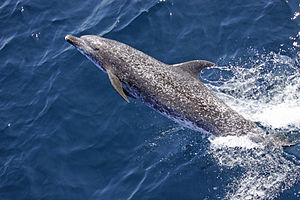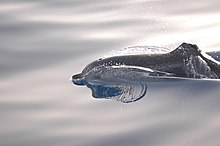Rein dolphin
| Rein dolphin | ||||||||||||
|---|---|---|---|---|---|---|---|---|---|---|---|---|

Rein dolphins |
||||||||||||
| Systematics | ||||||||||||
|
||||||||||||
| Scientific name | ||||||||||||
| Stenella frontalis | ||||||||||||
| ( Cuvier , 1829) |

The rein dolphin ( Stenella frontalis ) or Atlantic spotted dolphin is a species of the genus of spotted dolphins ( Stenella ). He lives mainly in the North Atlantic in the area of the Gulf Stream .
description
The color of the rein dolphin changes significantly in the course of its life. The calves are uniformly gray, later the upper half is colored gray, while the belly is whitish. Young animals have some dark spots on their belly and white spots on their flanks. In adult animals, the spots become denser and more numerous with age, until the entire body is covered. Fin and flippers usually have no stains.
This dolphin got its name from a drawing that runs from the head to the fin.
The fin and flipper are slender and sickle-shaped. The fluke (tail fin) is pointed at the end and has a slight notch.
Adult individuals reach a body length of approx. 2.2–2.5 m, their weight is 100–140 kg. They can easily be confused with the bottlenose dolphin and the slender dolphin on the open sea .
This dolphin has 64–80 sharp, conical teeth per jaw.
Like other species of its genus, the rein dolphin is a sociable animal. He is a fast swimmer and likes to do acrobatic jumps.
Taxonomy
Chinstrap dolphins were first described by Georges Cuvier in 1828 . The individuals of this species sometimes differ quite strongly, so that the experts were unsure about the correct classification for a long time. Therefore this dolphin species is / was also listed under other scientific names: S. plagiodon , S. pernettensis , S. dubia , Delphis dubius , Delphinus frontalis , Delphinus froenatus , Delphinus doris and Delphinus plagiodon .
Currently only one species is generally accepted. There is, however, the assumption that a subspecies ( S. plagiodon ) lives near Florida , which could possibly even be regarded as a separate species.
distribution
The rein dolphin is found in the temperate and tropical zones of the Atlantic. It has often been seen in the west of the Gulf Stream between Florida and Bermuda . It is also native to the Gulf of Mexico . Less often it was sighted east of the Azores and the Canary Islands . The northernmost sightings were between Cape Cod and the south-west tip of Spain. It can be assumed that there are also populations south of the Rio Grande do Soul (Brazil) - West Africa line, although little is known about this at present. They also live in the high seas in the Atlantic.
Due to the similarity to other dolphin species, it is difficult to give a reliable number of individuals. According to a conservative estimate, it should be around 100,000 animals.
Way of life
Fish and cephalopods serve as food .
The rein dolphin lives in small schools of 5–50 animals. However, groups of up to 500 animals are also observed off the Azores in July and August.
The animals usually stay on the surface of the water, but also dive up to 200 m deep.
Little is known about the hiking trails of the rein dolphins. Sometimes the animals alternate between shallow, coastal and deep waters. It is believed that the dolphins follow migrations of their prey.
Reproduction and development
The reproduction and development of the rein dolphin has not yet been studied in detail. It is assumed, however, that sexual maturity, gestation time , etc. correspond roughly to that of the slender dolphin. Sexual maturity is likely to occur between the ages of 10 and 14. The calves are believed to be carried for about 11–12 months and then breastfed for 1–1.5 years. At birth, the calves are 0.80–1.20 m tall.
At the moment nothing is known about the average life expectancy or the maximum age.
Web links
- Stenella frontalis in the endangered Red List species the IUCN 2006. Posted by: Cetacean Specialist Group, 1996. Retrieved on 12 May, 2006.

